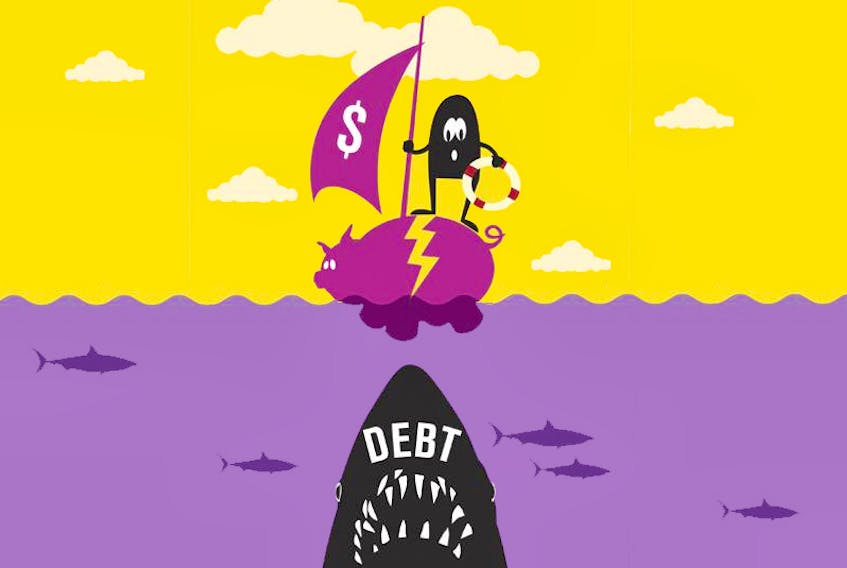Four years after launching Sandman Video in the late ’90s, Michael Sanderson went bankrupt.

He was then a single dad, living in an apartment with his young son, and he still remembers how it felt when the ugly truth finally sank in.
“It was horrible. I felt like I was a failure. It was the worst,” said Sanderson, now the acting director of the Sobey School Business Development Centre at Saint Mary’s University, in Halifax.
As scary as the prospect of insolvency was for the then-20-something, getting through it and having the bankruptcy discharged nine months later – something which should have been a relief – was even more frightening.
It was then Sanderson realized he was adrift in the credit world's equivalent of a no-man’s land, unable to draw on loans or credit cards for emergencies.
“The feeling coming out of bankruptcy was even worse because I thought, ‘What if something really bad happens?’” he said.
Every year, thousands of Atlantic Canadians face exactly the same financial dilemma and the same struggle to rebuild their credit rating afterwards. But financial experts think these bankruptcies and consumer proposals are only the tip of the iceberg, symptoms of a much bigger malaise that is seeing everyday Atlantic Canadians struggle financially and their credit ratings take a beating.
“There are a lot of Nova Scotians who have low credit scores,” said Robert Hunt, managing partner of Grant Thornton’s consumer insolvency business unit in Halifax.
A credit score is a three-digit number lenders use to make decisions about whether or not to lend money and at what rate of interest. A higher score is good. It means that person is a lower credit risk. A very low score can lead to a person being denied loans or credit cards.
“If someone was over 750, I’d say they have very good or excellent credit,” said Hunt. “Below 300, you need some work. And if you’re between 650 and 750, that’s considered good. You might not qualify for the lowest interest but you would probably be able to get credit.”
Although there are several methods used to calculate credit scores, they tend to look at how many times a bill payment was late or was missed altogether, what kinds of credit the person has in their name, how much credit they use compared to their credit limit, and how much they owe. Also considered in the calculations are how long those loans or credit cards or other forms of credit have been active and how often the person has applied for credit.

In a nutshell, fixing a bad credit score is simply a matter of acting in such a way as to convince banks, credit unions and credit card companies that they will get their money back.
As soon as his bankruptcy was discharged, Sanderson started to rebuild that trust by getting a secured credit card. He plunked down $75, got a credit card with a $150 limit, and started using it regularly to create a solid track record of paying off that bill.
“The idea behind that was not so that I could have a credit card again,” said Sanderson. “It was to show that I understood and could handle credit.
“I would go buy my groceries (with the credit card) because every month, no matter what, I had to buy groceries,” he said. “Then, I would go home and immediately use the money I would have used to buy my groceries to pay off my credit card. I never paid a cent of interest.”
Secured credit cards come with a variety of terms and conditions, including how much money needs to be left as a security deposit, so it pays to shop around.
Capital One’s Secured Mastercard, for example, currently offers credit limits of $300 to $2,500, depending on an applicant’s credit history, at an annual fee of $59 and interest rate of 19.8 per cent. It requires a security deposit of $75 to $300 which is kept by Capital One for as long as the user keeps the card. Then, if the account is paid in full, that security deposit is returned.
Refresh Financial’s Secured Visa, by comparison, comes with an annual fee of $12.95 and an interest rate of 17.99 per cent. The company’s website claims it requires a low security deposit but does not specify what it is.
Five years after his bankruptcy, the limit on Sanderson’s secured credit card had been raised to $1,000 and he was by then able to get a second credit card.
While he was rebuilding his credit rating, though, Sanderson had to struggle to buy things many people take for granted, like a new car on a payment plan. Three years after his bankruptcy, his car started to die. He went to a dealership and managed to qualify for a loan for a subcompact car. But at the time, Sanderson had to forget about zero-interest or low-interest car loans. Borrowing to buy that car came with an 18 per cent interest rate. His payments suffered for it.
Despite their higher interest rates, car loans for those with less-than-stellar credit can still be a good deal because they make the purchase of a vehicle possible and help rebuild a credit rating, said Hunt.
The real bonanza for someone with a poor credit history, though, is the cosignatory. When a parent or friend steps forward and is willing to guarantee a loan, suddenly credit opportunities are opened up for those who otherwise could not get financing.
“It’s a wonderful way for someone to re-establish their credit … and if the loan is guaranteed, the lender would still see it as a lower risk,” said Hunt.
N.L. leads Atlantic Canada in increased bankruptcies
According to the Office of the Superintendent of Bankruptcy, there were almost 13,300 bankruptcies and consumer proposals filed by Atlantic Canadians during the year that closed at the end of January.
Newfoundland and Labrador saw an increase in consumer insolvencies, with the number of bankruptcies and consumer proposals nudging up 3.6 per cent compared to the previous year in that province. The other Atlantic Canadian provinces fared better. On Prince Edward Island, the total number of personal bankruptcies and consumer proposals fell by 14.3 per cent that year compared to the previous 12-month period. In Nova Scotia and New Brunswick, the totals dropped by 5.6 per cent and 2.4 per cent respectively. Those three provinces also saw their annual insolvency rate fall that year.
Slow and steady wins the credit race
When it comes to rebuilding a credit rating, most financial experts urge consumers to take a long, hard look at what caused them to stumble in the first place and then carefully fix things one at a time.
“People should start slowly and cautiously when rebuilding credit,” said Robert Hunt, managing partner of Grant Thornton’s consumer insolvency business unit in Halifax. “They should really educate themselves about the types and costs of credit.”
Opening up a savings account and gradually building up to between three and six months’ worth of expenses by putting even a small amount aside every paycheque is one strategy.
“The point is that you’re making savings an important part of your plan, paying yourself first,” said Hunt. “Psychologically, it’s so important for people to see that there is money left over at the end of the month.
“It’s all about having a safety net in case you lose your job.”
For Michael Sanderson, who declared bankruptcy when his video store had to close, there were a lot of tough decisions to keep things going, right down to eliminating the cost of cable TV, Internet and phone.
Taking a page from Dave Chilton’s The Wealthy Barber, Sanderson, who is paid biweekly, also made the decision to live off two paycheques per month. On the months when the pay schedule provided him a third paycheque, he put only half of it towards his household budget. The other half went straight into an emergency savings account.
In the 16 years since he filed for bankruptcy himself, Sanderson has led many workshops to help people get their finances in order.
“It always surprises me … that there’s so many people that are going through this stuff.”
All of those struggling financially, though, can take comfort that proper money management can turn things around for them and lead to an improvement in their credit score.
In Sanderson’s case, the moment he realized his bankruptcy was truly behind him came when he applied for a mortgage.
“The guy went to check my credit and he turned to me and said, ‘Are you sure you went bankrupt? Because you’ve got a pretty good credit score.”









